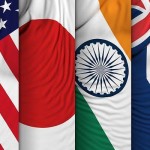The Quad, a unique grouping of the U.S., India, Japan, and Australia, held its second in-person leaders’ summit in Tokyo on 24 May and has emerged stronger and clearer in its strategy and goals for the security and prosperity of the Indo-Pacific. The efforts being made by the Quad countries should be viewed not only from the prism of the summits but also from the wider context of international developments as well as the continuing process of consolidation of the bilateral relations within, especially U.S.-India ties.
Beyond Ukraine
This summit, the fourth since March 2021 (two digital, two in-person) was the second interaction of the Quad leaders held after the Russian invasion of Ukraine. That war goes on, with no end in sight. With India abstaining from most anti-Russia voting in multilateral bodies, experts in India worried about the impact of Ukraine on the Indo-Pacific region, particularly the U.S.-India equation. Some feared that Prime Minister Narendra Modi would face fresh and intense pressure from the U.S. in Tokyo to condemn Russia and toe the western line. Others argued that the U.S. understood New Delhi’s nuanced and well-articulated position on Ukraine and may re-focus on China’s strategic game in the region.
The latter interpretation proved correct. India and the U.S. agreed to disagree on Ukraine but showed full readiness to further strengthen the Quad and their bilateral cooperation, which, President Joe Biden said, he was “committed to making…among the closest we have on Earth.”[1] With China, he has moved beyond the traditional U.S. stance of ‘strategic ambiguity and pointedly referred to Ukraine to stress that China’s armed action against Taiwan would be unacceptable and attract a military response.
Heart of Quad
The central driving force of the Quad is to counter China’s growing expansionism and belligerence stemming from its strategic goal to be Asia’s No. 1 power. The Quad has by now developed its own formulations to define its raison d’être without ever using the word – ‘China’. Aptly described as “proxy naming” by Navtej Sarna, a former Indian ambassador to the U.S., this diplomatic device was best reflected in the ‘Quad Joint Leaders’ Statement’[2] which reads, “We reaffirm our resolve to uphold the international rules-based order where countries are free from all forms of military, economic and political coercion.” Thus, China is not only the glue that holds the Quad together; it is also the fuel that may, through Beijing’s bad behavior in the future, drive the grouping’s inner consolidation, as shown by an expanding agenda.
The Quad agenda now covers nine sectors. These are vaccine partnership and health security, climate action, critical and emerging technologies, cooperation on infrastructure, cyber security, space cooperation, education, and people-to-people ties, maritime domain awareness, and humanitarian assistance and disaster relief. The Quad claims to have established “a positive and practical agenda” in the first year and in the second year it will focus on “delivery”. This needs to be watched.
Not all commitments have been met. The promise of making available at least one billion COVID-19 vaccine doses to Indo-Pacific countries has fallen short. Excluding what the Quad member-states contributed to the COVAX facility, just 25% or 265 million doses have been delivered to the region so far, with Cambodia and Thailand as the beneficiaries. This needs to be expanded rapidly. Meanwhile, Quad experts have already begun planning ways to enhance capacity for early detection and monitoring of “new and emerging pathogens with pandemic potential.”
On infrastructure, a new commitment was made at Tokyo for the Quad to extend over $50 billion in investment and assistance to the Indo-Pacific countries over the next five years. While the focus is on the ASEAN countries and the Pacific Island States (PIS), a part of this funding should perhaps reach the Indian Ocean region too, with its touchpoints in Africa. An announcement made at the summit on the Principles on Critical Technology Supply Chains is significant, as it concerns cooperation on semiconductors.
IPEF
The mood and atmospherics of the summit improved significantly after the launch of the Indo-Pacific Economy Framework for Prosperity (IPEF) a day earlier. This was planned for several months, and its finalization was timed with President Biden’s visit to East Asia. The joint announcement[3] was made by 13 countries of the region: the Quad, seven ASEAN member-states (excluding Myanmar, Cambodia, and Laos), South Korea, and New Zealand. The plan is to prepare their economies for the future by conducting negotiations on the four pillars of trade, supply chains, tax, anti-corruption and clean energy, decarbonization, and infrastructure. Even though the IPEF is not designed to lead to a traditional trade agreement, it has immediately been compared to RCEP and CPTPP, the existing trade pacts in the region. It is ambitious, but also doable; intentions must be well implemented.
India
India’s constructive and high-profile participation in the Tokyo summit and agreement to join IPEF demonstrated commitment to strengthening its strategic partnerships, both multilaterally and bilaterally, in order to push back China’s growing dominance. At the same time, New Delhi has not given up on BRICS; in fact, it has agreed to the expansion of BRICS membership, besides continuing with existing cooperation. This simultaneous engagement with the Quad and BRICS is New Delhi’s strategic autonomy in full play.
Finally, India’s approaching presidency of the G20 in 2023 and the likelihood of India hosting the Quad summit in 2024 will ensure that New Delhi follows a calibrated policy and stays on track, as every major step will attract international attention.
This article was first published in The Hindu.
Rajiv Bhatia is Distinguished Fellow, Foreign Policy Studies Programme, Gateway House, and a former ambassador.
References:
[1]https://www.whitehouse.gov/briefing-room/speeches-remarks/2022/05/24/remarks-by-president-biden-and-prime-minister-narendra-modi-of-the-republic-of-india-before-bilateral-meeting/
[2]https://www.mea.gov.in/bilateral-documents.htm?dtl/35357/Quad+Joint+Leaders+Statement
[3]https://www.mea.gov.in/bilateral-documents.htm?dtl/35353/Statement+on+IndoPacific+Economic+Framework+for+Prosperity


